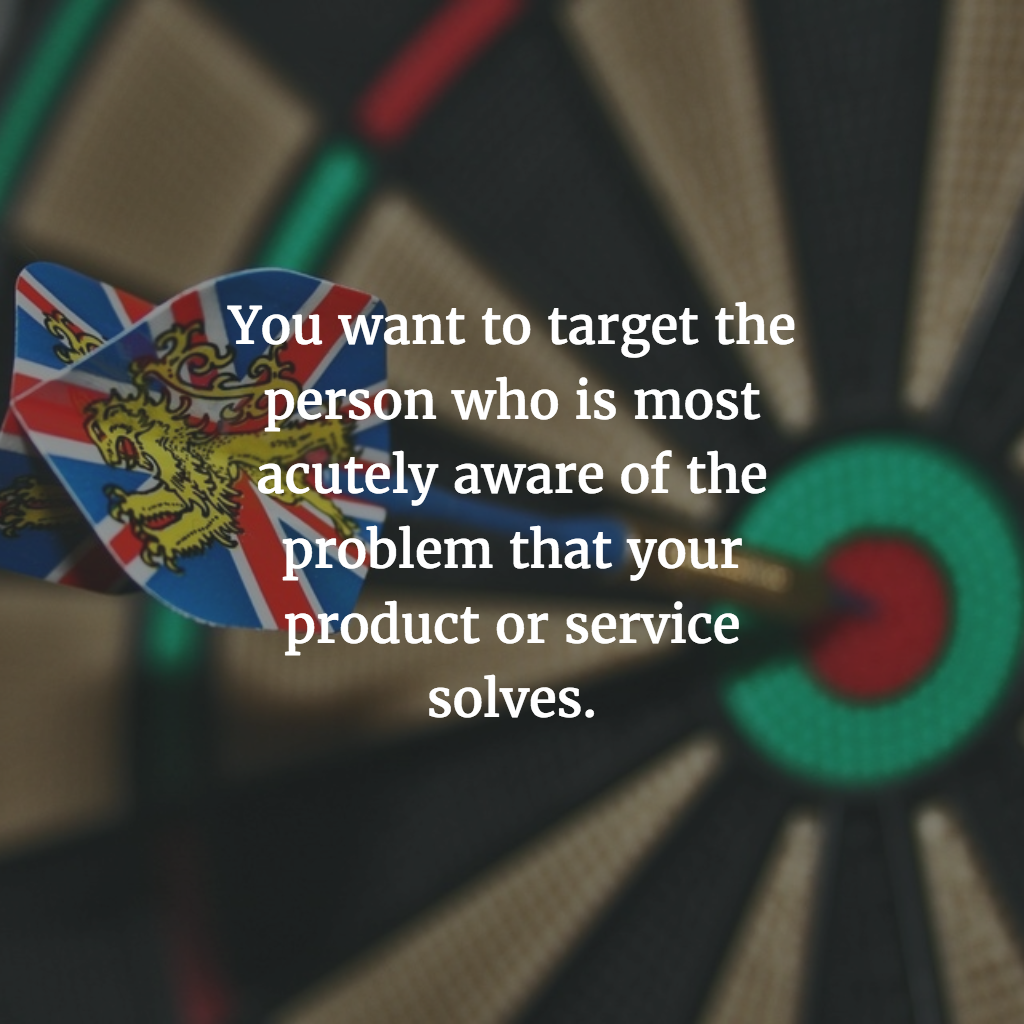At some point many businesses, and most professional service businesses, will go through a phase where they try cold outreach to generate new business. Traditionally that was cold calls and direct mailings but now often takes the form of cold emails (not to mention the blind Twitter follow). It is a law of the universe that these methods don’t convert as well as warm, inbound leads but when you’re looking to grow sales you will try anything.
There are methods for increasing the odds so that your outbound sales efforts go from feeling futile to being a repeatable source of new business.
Identifying customers to target
Obviously the first step towards cold leads becoming a viable sales channel for you is finding a good source for them. The easiest, but lowest quality, source would be to buy a list of leads. Those tend to be sold many times so the people on them receive a lot of sales calls already and are even more predisposed to ignoring you. They also come with none of the background information that is helpful in making a sale.
A better, but much more time-consuming, avenue is to manually source the leads yourself. My main method of doing so is Google searches. Every month I spend about four hours on a weekend watching movies and adding to my list of people to contact. “CPA Chicago”, “CPA Memphis”, etc. I go through about ten pages of results and manually copy the contact information into a Google Sheet. It is a lot of work but I end up with a list of people actively practicing their profession and can also make note of items of interest on their website or in their bio that I can include when emailing them. Those can be:
- Blog posts they have written
- Newspaper articles that have quoted them
- Conferences they have spoken at
- Whitepapers
- Industry accolades
- Where they went to school
- Interests
Including one of those in your email shows that you spent a little time researching them, that your email is personalized and not just spam, and that you appreciate them as an authority (they have worked hard to get where they are and like that to be acknowledged).
Even better than Google searches is going to where your potential customers hang out online (forums, Reddit, industry publications) and identifying them there.
You don’t want to target just any person at a company. You want to target the person who is most acutely aware of the problem that your product or service solves. If you sell time-off management software you would want to target HR. Expense reporting software you want to target accounting. When in doubt, and you’ve qualified the company as a good candidate, target the owner.

Before every cold call write a cold email
My favorite tactic to warm up a lead before cold calling them is to send them an email. It doesn’t turn them into a warm lead but makes them a slightly warmer lead. When you get then on the phone, or you leave them a voicemail, you are able to reference a previous communication. Instead of just saying, “not interested” they are more likely to say, “oh yeah, I saw that email.” They will be more likely to let you start a conversation with them.
One of my templates:
Hi <first name>,
I’m reaching out to you because you are the <job title> of <company name> and think you might be the person to talk to about <the problem your product or service solves>. I would love to ask you a couple of questions about how you currently <deal with the problem> to see if it is something we might be able to help with.
Do you have a few minutes for a quick chat?
Monday at 10:30 am EST
Tuesday at 2 pm EST
Thank you for your time and I look forward to talking with you.
Will
Sometimes you might want to give an extra push with your cold emails. For small businesses one tactic is to appeal to the owner’s growth goals while recognizing their cash flow fears (every small business owner has them).
When you are growing your business every dollar counts so it is good to get <some software or service> to handle <the problem> before you have to hire for it. This way you can keep dedicating resources to your core business while keeping <people from having the problem>.
End your cold email with the assumption that you are going to talk with your lead at some point. “Looking forward to connecting with you” subtly pushes them a nudge further down the funnel as more correspondence, and a phone call, is now a forgone conclusion. “I can’t wait to talk with you and see if we might be able to help <with your problem>.”
Tracking email opens
Knowing whether or not a lead has opened an email influences my follow up course of action. If I have sent somebody an email but it wasn’t opened then I might try again a week or two later with a slightly different email and different subject line. (Some people disable read receipts so you don’t want to send the exact same email.) If they don’t open the second email, but I really think they would be a great customer, then I try a phone call. If I have no reason to believe they are any different that any other prospect then I assume they aren’t interested right now and mark them for another follow up six months out.
If somebody has opened my email, but hasn’t responded, I call them a few days later. This way my email is still fresh enough in their mind that they remember receiving it and have maybe given a few moments of thought to possibly doing something about the problem that I can solve for them.
If you are sending your email through a CRM then it should have built-in open tracking. If you are using Outlook it has read receipts built in (though a lot of people don’t respond to them). Boomerang for Gmail also offers them among many other power email features.
The sales call

If you get your lead on the phone when you call start by introducing yourself and mention that you are following up on the email. My two biggest tips for the rest of the phone call are:
- Make the conversation about them
- Use the language they use
The best way to make the conversation about your customer is to ask questions:
- How do you currently handle <the problem>?
- What is one aspect of that process that works the best?
- What is one thing you would change if you could?
- Are you using any products or services <for this problem> currently?
These questions get them talking. Shut up and listen. When they stop talking ask another question. What you learn now helps you frame your solution as the answer to their specific problem. Use the word “you” instead of “I” or “we”.
Learning the language of your customers and the industry jargon helps to show that you understand the unique problems their business faces. Every business believes it is unique but you greatly increase your chances of making a sale if you make them believe that you have a background in their industry or have more than a casual understanding of it.
After you have asked them some initial questions you are then prepared to address them mentioning an aspect of how your product or service can help them. You are not giving an elevator pitch. You are learning about their problems and brainstorming ways to help them.
How and when to ask for a close depends a lot on what your product or service is and the price point. If it is low-priced and it easy to implement then you can ask if they are interested and immediately follow it by asking what it will take to make the sale. On the other hand, if you product is high-priced, complicated or time-consuming to implement, or would be part of one of their vital business functions then this is likely one of many phone calls, demos, and proposals you make. Your goal of this call is to schedule a second call.
If you initially only asked for a few minutes of their time then it is okay to ask if they have a few more minutes or if they would like you to send them some more information. Schedule a follow up call with them right then.
Things to not do on the sales call
The first thing to not do on a sales call is to be unprepared. It is important to be prepared and be in the right state of mind before picking up the phone:
- Be able to pronounce the lead’s name and look up their company on Google or LinkedIn so that you aren’t totally oblivious about their company (they spend at least eight hours a day working towards something and you can do them the courtesy of knowing what that is).
- Have an answer for each of the most common objections you hear.
- Do whatever is needed in order to get your mind and emotions ready for sales. It is often advised to put on a song that pumps you up or do some pushups. If you are having a bad day then skip the sales calls entirely. Work on something else (maybe building the lead list) and come back to the calls tomorrow.
Don’t be too direct with the qualifying questions on the initial call. When I receive a sales call and somebody asks me “how many employees do you have?” or “what is your annual revenue?” then my initial reaction is “that is none of your business”. That also suggests that they haven’t done any homework and that I am no more than a line on a spreadsheet for them.
The question that really gets to me the most is when somebody asks, “What is your budget?”. No! My thought is, “Tell me your price and let me decide if it is worth discussing further. You’re the one who called me! I know that the first one to name a number loses.”
Those are all alright questions for a second call but for the the first call they evoke the feeling of browsing on a car lot and being approached by the salesman.
Finally, throughout your life you have heard the advice, “don’t take no for an answer.” However when you are selling a definitive “no” is the second best thing you can hear after a “yes”. Embrace the no and move on to another lead.
The voicemail message
Often you don’t get the person on the phone and have to leave a voicemail. Always start and end by saying the person’s name:
“Hi <first name>”
Following the greeting I introduce myself:
“This is Will from Engage Tactics”
And remind them about the email I sent them:
“I’m following up on an email I sent you on <day of week>”
Then the meat of the call in no more than two or three sentences:
“As I said in the email, I’m hoping to ask you a couple of questions about <the problem> and how you are currently dealing with it. We <have the solution> and I would love to talk with you for just a few minutes to see if it might be a good fit.”
Your information so they can call you back (say this slowly so that they have time to write it down):
I look forward to talking with you. My number is (555) 555-5555. Again this is Will from Engage Tactics and my number is (555) 555-5555.”
And then follow that up with my ending where I again use their name:
“Thanks <first name>. Have a great day.”
Follow up
The follow up is one of the most critical parts of the sales process. People have a lot on their plate and they are always going to address the fires in front of them before investing time with you in order to keep those fires from starting in the first place. Short term needs trump long term goals. It is up to you to remind them that your product or service can start helping them (nearly) immediately.
Every phone call you have, even the ones where they say no, should have a follow up email. Go over what you talked about and what the outcome of the conversation was. Thank them again for their time. Mention that you look forward to talking with them again. Send a calendar invite if you scheduled a follow up call.
If they say no then still send a follow up email that thanks them for taking the time to talk with you and say, “if you change your mind and would like to talk again about <problem> and <your solution> my contact information is below.”
Emails also need to be followed up on. If you sent an email request for a phone call and didn’t get a response then wait a week and send another request. Then do that again. Every lead should be contacted a minimum of three times before you move on. I would estimate that a third to half of my leads that have responded did not respond to the first email.
Document everything

The key to getting a cold lead sales process to work is to make a record of each communication. You can use one of the many CRMs out there to track all of this (I particularly like Close.io for outbound sales) or even use a free tool like Trello with a card for each prospect. Just make sure that you can always look up where in the funnel each lead is, when you called or emailed them, and what the outcome of any conversation was.
Secondly, when you find that you are getting some traction with your sales process then document it. In a Google sheet, an Asana project, or somewhere else, list each step of the process with extreme detail. By doing this you will be able to hire people to handle different parts of the process for you. If you know you can turn x leads into y dollars and that paying somebody to find you x leads (with your documented process) costs less than $y then you have created a sustainable sales channel.
Cold selling is hard work but builds character and is one of the best ways to learn more about your customers and how you should frame your solution to them across all of your sales channels.

